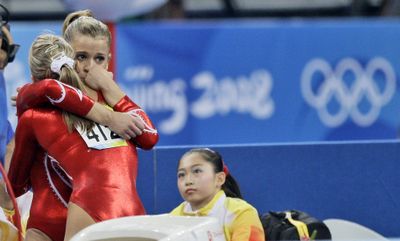China defeats U.S. for gymnastics gold

BEIJING – The biggest, fiercest rivalry between the U.S. and Chinese Olympic teams involves the tiniest athletes on both teams, the pony-tailed pixies with rock-hard muscles and nerves of steel. Women’s gymnastics is one sport in which the U.S. and China both dominate, and this city prides itself on its spectacular acrobatics shows, so today’s women’s team final was the hottest ticket in town.
A crowd of 18,000 packed the National Indoor Stadium to see the showdown between the past two world champions, and it lived up to expectations. Hundreds of fans chanting “U-S-A!” and waving American flags were drowned out by the deafening cheers of the hometown fans.
The loudest cheer was yet to come. China won the gold medal thanks to brilliant bar routines, few mistakes, and two critical errors by U.S. gymnast Alicia Sacramone, a 20-year-old Brown University student and the team’s emotional leader.
Sacramone fell as she got onto the balance beam, and fell during her floor exercise. The most expressive gymnast on the U.S. team, Sacramone buried her head into her hands as her floor score (14.1) was posted. So long as China performed well on floor, it would win the title, and that it did. The event ended with a flawless routine by Cheng Fei, and the Chinese fans erupted from their seats.
China tallied 188.9 points. The U.S. won the silver with 186.525 points, and defending champion Romania won bronze with 181.525.
China had taken a slight lead after two rotations. The U.S., nicknamed The Beam Team for its success on that apparatus, figured to make its biggest marks on the third rotation, but Sacramone fell as she launched herself onto the beam. She looked shaky at a few other points of the routine and scored a 15.1. The U.S. remained in second place heading into the final rotation – the floor exercise.
Sacramone, known for her strong floor routines, slipped and fell on a landing, and the U.S. all but lost the gold medal at that moment. Nastia Liukin scored a 15.2 on her floor routine, and reigning world champion Shawn Johnson scored a 15.1. Not enough.
Both teams wore shiny red leotards, but they were a contrast in styles. The Chinese are more petite, and incredibly fearless, hurling themselves without hesitation between the uneven bars. Across town, at the Chaoyang Theater, teenage acrobats leap off seesaws onto each other’s shoulders, and flip plates onto their heads while balancing on a beam. The Chinese Olympians can be equally breathtaking.
The Chinese are also younger than the U.S. gymnasts. Four of the six gymnasts are 16, or so say their passports. Published reports alleged that three of them – He Kexin, Yang Yilin, and Jiang Yuyuan – were really 14 and ineligible to compete, but the international gymnastics federation and International Olympic Committee backed the Chinese athletes.
The Americans are taller, more muscular and more powerful. As a result, their bodies take more pounding, which is why several of them are often hobbling on bad ankles or wearing ankle braces. They also are older. The U.S. team includes an 18-year-old and two 20-year-olds.
Paired together in the same group, the teams competed first on vault. Three-time vault world champion Cheng scored a 16.0, and Johnson matched her. After the first of four rotations, Russia led, followed by China and the United States.
The U.S. and China moved onto the bars, and that’s where things got exciting. Chelsie Memmel, 20, a former world champion who had fallen off the bars during the qualifying round, nailed her routine and earned a 15.75. Johnson, whose routine isn’t difficult, added a 15.3, and then Nastia Liukin took the stage.
The balletic daughter of 1988 Olympic champion Valeri Liukin of Russia was raised in Texas and is coached by her father. Her bar routine, which features eye-popping pirouettes and release moves, is among the most difficult in the world and the judges rewarded her with a 16.9, the highest mark of the night.
There were eight teams competing, but all anybody was talking about was USA vs. China.